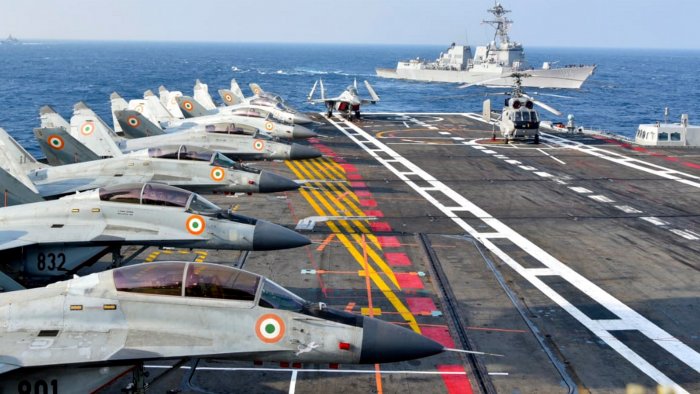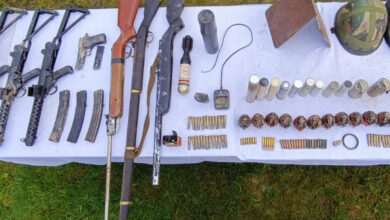U.S. Military Deals Struggle To Displace India’s Reliance On Russian Arms

- India is also part of the QUAD alliance with the U.S., Japan, and Australia, which strengthens its ties with the West but does not replace its decades-long friendship with Russia.
- Derek Grossman, a defense analyst at the Rand Corporation, said that this is why the U.S. will always be careful about what military hardware and information it shares with India.
Security officials and experts say that India’s multibillion-dollar purchases of U.S. arms are less about moving away from Russian defense equipment and toward the West and more about building up its own weapons industry.
India buys the most weapons of any country in the world, but almost all of its major weapons purchases now include plans for shared production or the transfer of technology, no matter what country it is dealing with.
Also, Russia’s war in Ukraine has stopped some military supplies to India. This has made Indian defense officials say that New Delhi wants to diversify its imports or replace them with weapons made in India.
According to statistics from the Stockholm International Peace Research Institute, India has spent more than $60 billion on weapons in the last 20 years. Of that amount, 65%, or nearly $39 billion, came from Russia.
India’s Defense Minister Rajnath Singh has said that the country plans to buy more than $100 billion worth of weapons from its own arms business over the next ten years.
“It is a fact that we need to be less reliant on Russia,” said a top Indian defense officer who works on the future capabilities of the Indian military but didn’t want to be named. “But that’s the second part. Part one is the attempt to get out of the import business.
During Prime Minister Narendra Modi’s state visit to Washington last month, India said it would buy a lot of defense equipment from the U.S. This included an order for fighter jet engines from GE (GE.N) worth more than a billion dollars. A deal for MQ-9B SeaGuardian drones that could cost $3 billion is also being talked about.
In line with New Delhi’s goal of being self-sufficient in defense and Modi’s “Make in India” strategy, the jet engine deal includes joint manufacturing in the future, and the SeaGuardians will likely be assembled and maintained in India.
Eric Garcetti, the U.S. ambassador to India, said that Washington had given “lip service” in the past, but that it was now making it easier for India to get access to defense technologies. He said that the U.S. was “leaning in” with technology by sharing more with India than with some of its closest friends.
But the steps taken so far won’t be enough to end New Delhi’s dependence on Russia, and for now, the future is limited by the strict rules the U.S. has about sharing defense technology.
“No one gives you all you want. “They keep you at least a screwdriver away from having it all,” said a second top official from India’s defense ministry, who also spoke on the condition of anonymity.
Arzan Tarapore, an Indian security expert at Stanford University, said that the deals announced during Modi’s stay “do not in and of themselves represent an Indian shift away from Russia.”
“It will take decades to make a big change away from Russia,” he said.
GAP WITH CHINA
India still makes most of its standard weapons with Russian technology. Tarapore said that new methods that India doesn’t already have should be where the U.S. and India should work together the most.
India’s main goal is to close the technology gap between it and its archrival China, which has better weapons than it does and is close with India’s old enemy Pakistan.
One of India’s problems is that Russia’s war in Ukraine has made it much harder for Moscow to send arms and equipment to India.
India’s air force recently told a government panel that Russia would delay sending spare parts for MiG-29 and Sukhoi Su-30 MKI jet fighters. It also said that a big-ticket item, thought to be the last two of the five Russian S-400 air defense systems India bought in 2018 for almost $5.5 billion, had been delayed.
India also thought it would get two nuclear-powered attack submarines from Russia in the next few years, but defense sources say that could also be delayed.
India is more determined than ever to become less reliant on Russia because of these problems, but it doesn’t want to buy weapons from just one country, they said.
It is getting fighter jets from France, drones from Israel, jet engines from the United States, and maybe even submarines from Germany. India will use less Russian defense technology over time because of these purchases, but Indian officials say it will take at least 20 years for this to happen.
LEAST LIMITATIONS
Bill Greenwalt, a former top Pentagon official for industrial policy, said that the days of the U.S. and Russia dominating the global defense market and being able to control defense technology were coming to an end, but that what would replace them was “still a work in progress.”
He said that India could get upset with how strict the U.S. is about controlling the export of weapons and how it limits India’s ability to share information and make improvements to systems it buys.
He said, “I think India will look for ways to work with the West with those countries that can transfer technology with the fewest restrictions on how it can be used.”
Exports to India must follow strict U.S. International Trafficking in Arms (ITAR) rules, and the two countries are not treaty allies. This means, for example, that the AUKUS deal, which would have given Australia nuclear-powered submarines, cannot happen.
Even so, Modi’s trip to the U.S. has been praised by both countries as a step forward in their relationship. In addition to the defense deals, the two countries also signed agreements about chips, space, artificial intelligence, and vital minerals.
India is also part of the QUAD alliance with the U.S., Japan, and Australia, which strengthens its ties with the West but does not replace its decades-long friendship with Russia.
Derek Grossman, a defense analyst at the Rand Corporation, said that this is why the U.S. will always be careful about what military hardware and information it shares with India.
Grossman said that even if India can move away from Moscow over the next few decades, “the U.S. will still have suspicions about how their systems are being used and how that might help the Russians in some way, because of the close partnership between India and Russia.”
“In this situation, India will look for opportunities and take whatever the U.S. is willing to offer. But I don’t think they’re ready to give up what they have with Russia.”







Facebook Comments